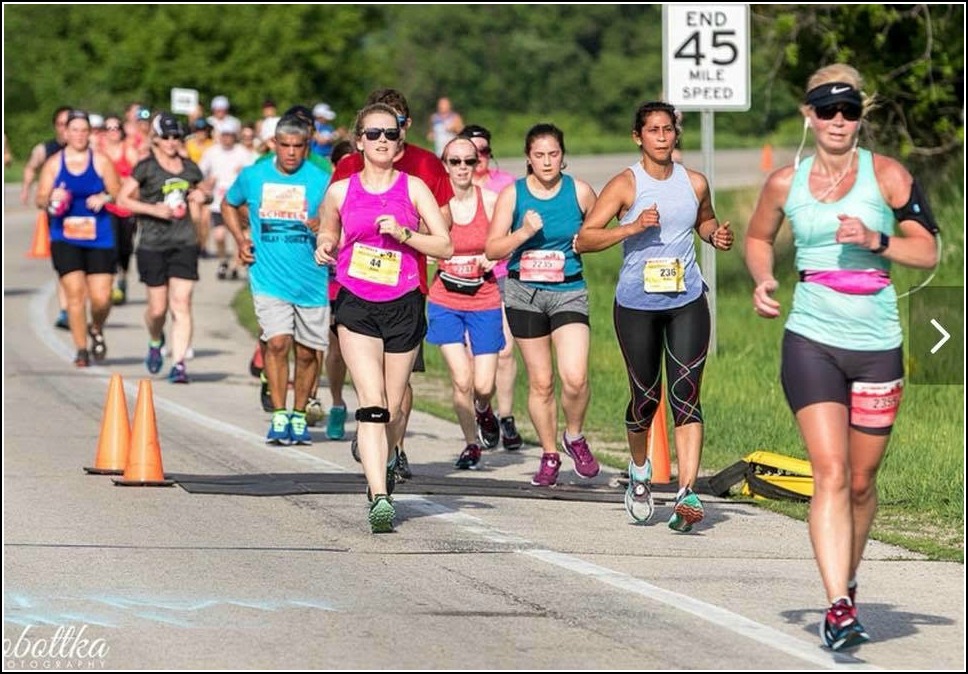Twelve years ago, I had a Michael Phelps moment. I was eating nearly twice as much food and still feeling famished all day (I didn’t gain a pound, either).

Here’s Jodi, leading the pack with high energy!
You see, I was pool running every day because of an injury (sometimes, twice a day). With all that time in the pool, my appetite soared. Now, I understand how Michael Phelps can eat 10,000 calories per day!
Water does that to you. Water, which is a better conductor of heat, makes you colder. To compensate, your body revs up your metabolism to stay warm.
That’s why I had a hot dog and three bowls of cereal for dessert (not ideal, by the way…) and was clamoring for nachos at 9pm.
But running is not swimming. You’ll never need to eat that much to sustain your training, even if you’re running triple digits per week. There’s no water to cool down your body temperature.
Alas, that doesn’t mean runners can under-fuel. In fact, eating enough food is often a problem for many runners that leads to low energy availability. That makes workouts, long runs, and races much more difficult.
Awhile back, I spoke with elite trail runner David Roche about prevent injuries. His advice? Eat more.
To have a long-term running career sustaining lots of miles, you need to be a champion eater.
The mechanism at work is energy availability. Running burns lots of calories, and life burns lots too. Runners need to make sure they are never at a deficit when accounting for all of those demands on energy. A deficit for even one day during heavy training can increase injury risk. A longer term deficit can have even more disastrous consequences on hormones.
Moreover, erring on the side of a surplus energy availability is helpful in spurring adaptations to heavy training, and it allows a runner to sustain harder work over time.
Now let’s be clear: you have to eat good food to get these benefits! Nutrient-dense, minimally processed food is your best option.
And you can see how sound nutrition is a performance multiplier. It:
- Reduces your injury risk
- Provides enough energy for high quality workouts
- Makes you feel better throughout the day
- Improves the recovery and adaptation processes (this is what makes you faster)
It’s a powerful method of multiplying your efforts to get more out of your training – with zero drawbacks.
Let’s see how this works in real life. Meet Jodi:
“I could feel my low energy”

Jodi started running when she was 35 but never put any “structure” around her running or diet. She just wasn’t sure what to do.
But she also had aspirations to run a marathon and knew that if she was going to accomplish her goal, she needed a smarter plan. What she was doing just wasn’t working.
I could definitely feel my low energy when increasing my miles, but also just in my everyday life. I was at the point where I was not following any program.
I was tired of throwing my money away on information that did not work or help.
I wanted to learn how to fuel my body to help my distance running and to keep from getting injuries. My goal is to run my first full marathon.
Jodi took the leap and started implementing Strength Running’s nutrition guidance – and her progress quickly accelerated. But she did struggle a bit at first!
Nothing good ever comes easy…
She knew that she needed to have a better relationship with food (and since we don’t make you score, weigh, calculate, or count anything this was an easy transition for Jodi) but she wasn’t sure what to eat, when to eat, or the right portions.
Luckily, our example Meal Plans explain this in simple terms. And our RD-approved grocery list only has “normal” foods on it (no need to travel to a specialty store!).
And Jodi got exactly what she was looking for:
Until I got this program, I was not fueling my body like I should which was why I struggled with my runs and energy.
When I started this program I gained weight at first, which was a little hard and challenging for someone recovering from an eating disorder, but once my body adjusted the weight can back off and my body started to lean itself out.
I started to actually look healthy.
Perhaps more importantly, Jodi started feeling better the other 23 hours of the day when she wasn’t running. After all, you can’t enjoy life if you’re always too tired from running.
She told me:
I felt so much better in all aspects of my life and had so much more energy not only on my runs but just overall. It was not just learning to fuel my body for running but for all aspects of my life!
Your program is not just about feeding information to people but that you or the experts you use all practice what you all preach. Which is why I like this program and why it works.
That last part is probably the most satisfying to me as a coach because no matter the advice (whether it’s to focus on nutrient-dense foods, stop counting calories, or abandon all those fad diets), it’s all advice that’s practiced by us and by all of the experts we spoke with.
It’s not a coincidence.
Fundamental principles of nutrition that help you fuel well, establish your ideal weight, and improve feelings of well-being aren’t secret, difficult to adhere to, or complicated.
They’re fundamental.
How to Energize Your Running like Jodi
These principles can help any runner no matter the age, ability, weight, mileage, or injury status. We’re all runners aren’t we?
Jodie took advantage of our no-nonsense programming to transform her running and daily energy levels.
In particular, I want to highlight two from the program:
Simple is King
Look, if you want to assign a score to every morsel of food that enters your body, then you’ll have my blessings.
But I’m not interested in calculating my macronutrient percentages several times a day or keeping an ongoing calorie log of my diet. I have better things to do – like cutting my lawn by hand with a pair of kid’s scissors.
You might feel the same way…
That’s why we keep our program simple. No calorie counting. No worrying about your diet “score” or stressing about your carbohydrate count for the day.
It’s not only more enjoyable, but it’s sustainable in the long-term. Adherence rates plummet with complicated diets.
And that’s why it’s not even a diet! Just a smarter way to eat.
Eat Foods for Energy
Nutrient-dense foods fill you up but nutrient-poor foods often leave you famished just an hour later.
We’ve all had the experience of eating a huge fast food meal, only to be hungry again soon after.
Why does that happen? A few reasons:
- Processed foods generally have far less fiber than “real” foods – so they’re digested faster.
- The have less “nutrition” (i.e., nutrients like vitamins, minerals, polyphenols, fiber, etc.)
- High sugar content from white bread, soda and fries spikes insulin, resulting in a crash that leaves you wanting to get your blood sugar level back up
- High sodium levels can make you feel thirsty, which is often mistaken for hunger
These empty calories don’t satisfy you the same way that a balanced meal with whole foods will.
A properly balanced meal includes every macronutrient:
- Healthy fats (from fish, nut butters, avocados, olive oil, greek yogurt, etc.)
- Complex carbohydrates (the less refined the better)
- Lean protein
When you include every macronutrient, rather than just one or two, you stay full for longer. Your digestive system has work to do and while your stomach is busy digesting, hunger cues are greatly reduced.
In our free nutrition course, we cover more examples – plus give you a free dietitian-approved shopping list, case studies, what not to do, and a lot more.
Want these lessons? Just sign up here and the first lesson will be on its way!